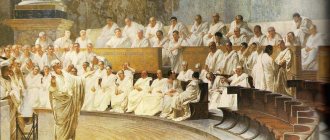To have enviable eloquence, to always win an argument, to be the center of attention at ease, to gain support or simply to clearly share your opinion, is this not the dream of each of us?
Originating in the era of antiquity with its Pericles, Socrates, Cicero and Caesar, in our information age, oratory finds a variety of applications - from teaching to politics.
Particularly indicative is the example of Demosthenes, who, despite physical disabilities, through long and persistent training of his skills, achieved world fame along with Alexander the Great. Not everyone is born with a “tongue without bones”, possessing all the necessary oratorical qualities.
As in any art, painstaking work on honing one’s own skills is important, artists work on strokes and strokes, musicians play scales for hours, and a skilled speaker improves the quality and content of the audience’s perception of his speech.
A real speaker seems to be “conducting” the listener; with a short change in intonation he is able to carry him along with his stream of thoughts and not let go.
Great articles to check out:
History of rhetoric from the Middle Ages to the Renaissance
Ancient Roman rhetoric
Ancient Greek rhetoric
By educational space we mean...
Zotova Larisa Anatolyevna
Renaissance
In the 16th century, a period marked by a huge increase in interest in the creation of vernacular rhetoric to satisfy new identities in the use of vernacular languages, the French philosopher Petrus Ramus and his followers simply completed the nascent fragmentation of rhetorical theory by establishing offices as separate specialties.
Ingenuity and predisposition were attributed to dialectic, the by then largely silent art of argument, which in the Ramist system emphasized self-evident axiomatic statements.
Memory was seen not as a matter of creating sound effects to enhance the retention of a speaker's ideas, but as a matter of efficient arrangement, so that separate attention to memory disappeared.
Oratory and pronunciation were considered the only two positions inherent in rhetoric, and they were subject to special censure.
Oratory, or style, became the center of rhetorical theory, and in the hands of the Ramists it was concerned almost exclusively with figures of speech. In fact, a strong emphasis on figures of speech developed from the late Middle Ages.
In responsible learning, as linguistic postures, postures, gestures of the mind in opposition to external reality, figures served a useful purpose; and in Renaissance education they were widely used, as in the modern manner, in the interpretation or analysis of discourse.
Less responsibly taught, the figures became mere decoration, like Aristotle's metaphor. In the Ramistic system, figures fluctuated between serving as arguments and serving as external decoration.
Figures of speech fell into even greater disrepute in the new culture of the Renaissance, which was characterized not only by an enthusiasm for printed colloquial language in a “plain” style, but also by a growing bewilderment about the doctrines of the passions.
For centuries, rhetoricians taught figures of speech as a means of “strengthening” ideas so that they could appeal to the passions of the audience. In Ramus, rhetoric abandoned its principles of intensification, leaving the passions to be discussed mainly by “moral philosophers,” who fought passionately over which passions were ordinary and which were not.
Ultimately, the passions themselves became the subjects or objects of the new scientists, who divorced them from moral or religious dogma.
It was only at the end of the 18th century that the doctrines of the passions again came to the attention of the rhetorician; however, at the time these figures were seen less as appeals to the passions of the audience than as manifestations of the psychology of the author or speaker—or, to use the metaphor used earlier, as places on the map of his mind.
Another part of the fragmented Ramist rhetoric, pronunciation or action, was rarely mentioned during the Renaissance; it had not yet been brought to perfection, it was the Ramists’ justification.
The first real impetus for the scientific study of spoken English came at the beginning of the 17th century by Francis Bacon, who, dealing with rhetoric in his works, called for a scientific approach to the study of gestures. The Ramists created a context in which Bacon's appeal would have special force and significance.
John Bulwer's chirology (1644) was the first work to respond, and in its wake came a plethora of studies of the physical, non-verbal expression of ideas and passions, including the work of Charles Darwin and Alexander Melville Bell in the 19th century and the modern work on the “silent language” of the American linguist Edward T. Hall.
Help from “Foma”. Samples of Russian oratorical classics
Famous judicial figures of the second half of the 19th - early 20th centuries, F.N. Plevako, A.F. Koni, P.S. Porokhovshchikov, were distinguished by their judicial eloquence; academic eloquence - university professors, historians T. P. Granovsky, V. O. Klyuchevsky, philologists I. I. Davydov, F. I. Buslaev, I. I. Sreznevsky - in the 19th century, N. I. Konrad, V. V. Vinogradov - in the twentieth century. Many church speakers were examples of spiritual eloquence: Metropolitan Philaret (Drozdov), Holy Righteous John of Kronstadt. We find examples of political eloquence among the Kiev princes, and among the associates of Peter the Great (Feofan Prokopovich), and in the proclamations of Alexander I, written on the occasion of Napoleon’s invasion, and in the speeches of figures of the early twentieth century - Stolypin, Witte and many others.
On the screensaver there is a fragment of the TEDxSydney photo
Traditional rhetoric
Traditional rhetoric is limited to the concepts and terms developed by the rhetoricians, or rhetoricians, during the classical period of ancient Greece, around the 5th century BC, to teach the art of public speaking to their fellow citizens in the Greek republics and, later, to the children of the wealthy under the Roman Empire.
Public speaking was considered the highest achievement of education, and rhetoric was at the center of the educational process in Western Europe for 2000 years.
Of course, in such a long tradition there were slight changes in emphasis, and for a long time even letter writing came within the realm of rhetoric; but she consistently maintained her emphasis on teaching, on instructing those who wanted to begin communicating with other people.
The basis of speech is the plan
We must remember that rhetoric is not only the ability to speak beautifully. It is also the art of harmonious, logical thinking.
Without the ability to structure speech, without a clear plan based on consistent, coherent theses, it is impossible to speak convincingly and intelligently. The basis of any, even the most emotional speech, is a verified, thoughtful concept. Otherwise, the speaker will begin to repeat himself pointlessly, miss important facts, and stammer.
Another point that is not directly related to the ability to communicate with an audience is diction. Listeners should concentrate on the speech, and not be distracted by the need to understand the slurred pronunciation of the lecturer.
They say that Demosthenes, in order to achieve perfect pronunciation, practiced oratory by putting several stones in his mouth. It sounds funny, but this is really a good way to improve your diction - unless, of course, there are serious problems that require the help of a specialist. And, of course, tongue twisters. Even announcers use them for training.
Modern rhetoric
Modern rhetoric has shifted its focus to the auditor or reader.
Literary criticism has always borrowed stylistic terms from rhetoric, such as antithesis and metaphor were invented by classical rhetoricians.
Modern rhetoric is much more than a set of terms. The point of view from which he views the text differs from that of other disciplines.
History, philosophy, literary criticism and social sciences tend to view a text as a kind of map of the author’s consciousness on a particular topic.
Rhetors, accustomed to their traditional discipline of viewing communication from the communicator's point of view, view the text as an embodiment of intention, not as a map.
Concern with audience, intention, and structure is a hallmark of modern rhetoric. It is as much connected with the process of interpretation, or analysis, as with the process of creation, or being.
Modern rhetoricians identify rhetoric with a critical perspective rather than with a work of fiction. They justify the expansion of their interests into other literary fields on the basis of a change in thinking about the nature of the human mind.
Related posts:
- Ancient Greek rhetoric The reasons for the emergence of the art of rhetoric in Ancient Greece. Its founders. Influence…
- Why a teacher needs to master the basics of pedagogical rhetoric Rhetoric teaches us how to correctly convey our thoughts to our interlocutors in...
- What is "War and Peace" about? Summary of the novel “War and Peace” by chapters. All answers...
- Features of the formation of sensory standards in young children Formation of sensory standards in preschool children. The tasks of forming sensory…
Internal classification
Rhetorical science is divided into two main types - general and specific.
They are understood as follows:
- General rhetoric is a science that studies universal paradigms (what is this?) and the rules for creating high-quality (effective and beautiful / only effective) speech. It does not affect specific areas.
- Private rhetoric is more applied in nature. It is built on separate types of communication (how is that?) and depends on the sphere of life activity.
How many private rhetorics ? Hard to say. As many as there are areas in which a person must communicate and communicate.
We can name the most voluminous ones:
- political,
- judicial,
- solemn,
- theological,
- academic,
- business,
- journalistic.
The first four are called traditional; they were identified a long time ago. The remaining three are acquisitions of recent centuries.
There is another classification . So, rhetoric happens:
- Theoretical. Explores the rules of creating good speech.
- Applied. Uses the highlighted rules in practice.
- Thematic. Studies the fields of different types of literature, united by one topic. As an example, the rhetoric of the presidential elections.
The public is not scary at all
Rhetoric is a conversation, not reading a text from a sheet. Speech must be learned from memory, and practiced until it sounds like free improvisation - that is, easily and effortlessly. There is nothing more difficult than creating the illusion of ease. The lightest grace of ballerinas is the result of enormous work.
You need to train constantly. On family, on friends, on your beloved dog - she will definitely listen with interest, even if you tell the same thing a dozen times. When you develop the habit of speaking easily and smoothly, without faltering, speaking in public will become much easier.
For many, the problem is precisely that standing in front of people and speaking is a scary, unnerving process. Practice will help here too. You can try to speak at a parent meeting, at a meeting in front of the team, or give a short speech at a corporate party. There will be, although not relatives, familiar, friendly people around. In such conditions, it will be much easier to get used to the public’s attention.
Speech must be literate
Russian rhetoric has a characteristic feature. She is demanding of the language, or more precisely, of the style of speech.
This is an important factor by which a speaker’s oratory skills are assessed. It is expected that the speaker must master the classical literary style and not fall into slang, jargon or local dialect. Of course, there are exceptions - for example, speaking in a narrow professional environment or in front of voters, when you need to look like “one of your own”. But more often such speech is perceived as a manifestation of lack of education and low culture. And then confidence in the speaker decreases.
Alas, learning to speak correctly is much more difficult than correcting diction. The best way is to read good literature and communicate with intelligent people. If you don’t have time to read, you can purchase several high-quality audiobooks and listen to them in your free minutes. This will form the habit of speaking in correct literary language.
Dialogue with the public
Such retreats should not be too frequent, but not rare either. They allow the audience to take a break, mentally summarize what has been said, and prepare for the next part of the speech, which is not so lively and exciting.
To determine whether the listeners are interested, whether the tempo and intonation are chosen correctly, you need to find a person in the audience who evokes sympathy and speak “for him.” This technique is often used by aspiring actors, and modern rhetoric has much in common with theatrical art. Firstly, it’s easier to forget about the audience and the audience watching the performance. Secondly, by observing a specific person, the speaker creates the illusion of dialogue. He sees the emotions caused by speech, notices when a person is distracted and begins to get bored, and when, on the contrary, he sympathizes with the thoughts expressed.
Listener-centric
The basics of rhetoric require the ability to structure speech and tailor it to the audience. That is, you need to learn how to write a plan and fill in the points with fragments of text that have a purpose.
A speech aimed at miners is not at all the same as a speech that will be delivered at a board of directors. And the point is not at all that someone is better or worse. These audiences just have different interests and different tastes. The speaker must take this into account when compiling a summary of the speech. With the same basis, such speeches require different means of expression and different examples. An intelligent audience is unlikely to appreciate the speaker’s excessive expressiveness, but people who are accustomed to openly expressing their feelings, on the contrary, will sympathize with an emotional speaker.






